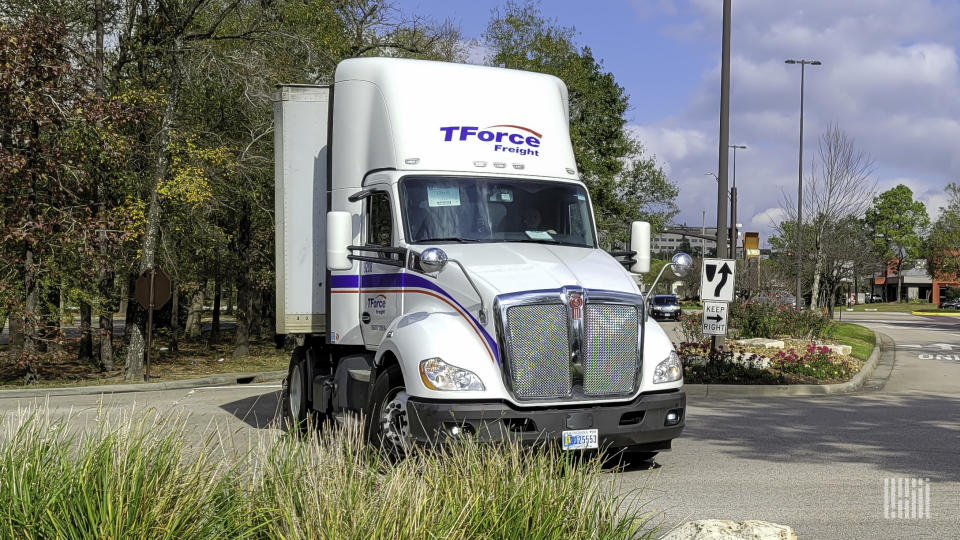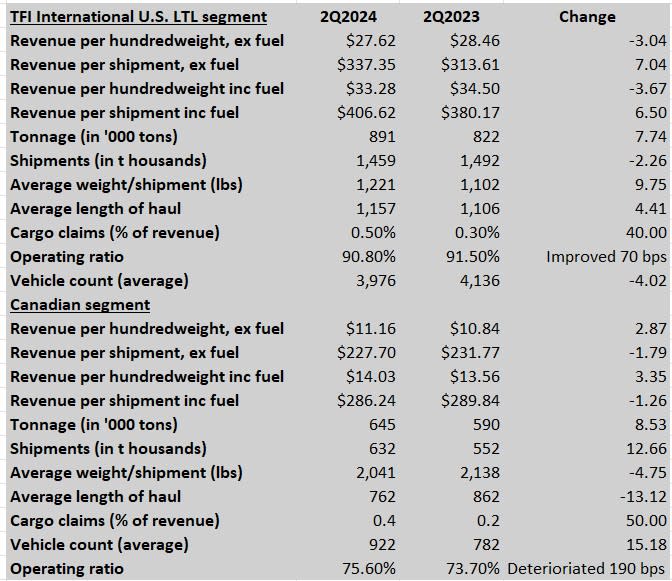‘We’re too fat’: TFI International CEO targets costs at US LTL operations

With revenue at TFI International ever more dependent upon its activities in the less-than-truckload sector, it is no surprise that was CEO Alain Bedard’s main focus for much of the company’s earnings call with analysts.
The call was entirely Bedard; no other TFI (NYSE: TFII) executives joined in, unusual in any industry.
TFI’s U.S. LTL operations sported a second-quarter operating ratio above 90%, and LTL accounted for 42% of company revenue, so it drew most of Bedard’s attention – and critique.
OR at TFI’s U.S. LTL operations was 90.8%, an improvement from the 91.5% of a year earlier. Asked by an analyst if TFI could get that down to meet an annual target of 88% by the end of the year, Bedard was characteristically blunt.
“No, it is impossible,” he said. The company’s target insead is to break below a 90% OR by the end of the year.
The 88% OR target was set in the fall of 2023. “When I listened to our guys, our team, we thought we would grow our shipment count at the same time as reducing costs,” Bedard said.
But LTL shipments have not increased. They were 1.46 million in the second quarter compared to 1.5 million a year ago. “We anticipate that probably by year-end, we’re still maybe going to grow the shipment count a little bit but not much. So really, the name of the game to break the 90 OR is going to be all cost for us.”
“We’re too fat,” Bedard said of TFI. “We’ve got too much cost. If you compared our U.S. costs versus the way we do business in Canada, we are too fat. So we have to attack the costs.” TFI International’s OR in Canada is sub-80%, though its revenue is less than 30% of U.S. revenue.
TFI’s giant leap into the LTL market came when it bought UPS Freight in 2021. The business was rebranded as TForce Freight.
Without identifying what was clearly Old Dominion Freight Line (NASDAQ: ODFL) by name, Bedard referred to “the best player in the U.S. and those guys are doing really well. Why? Because they’re way better than us on managing costs.”
Info at the terminal level
One route to getting there, Bedard said, is that the company “finally” has financial information by terminal.
Bedard provided his inimitable description of what that could mean. “If you have a manager that sits on his hands, well, that’s not going to help us,” he said. “So these guys have to go, and they have to be replaced by a manager who wants to do things and wants to reduce costs and be more efficient.”
Regarding shipments, the issue is not just about volumes. It is also about what is being hauled.
Adding tonnage to shipments
“When we bought UPS, these guys were hauling an average weight of 1,075 pounds [per shipment],” Bedard said on the conference call. “So now we’re just a little bit above 1,200 pounds. But if you look at my peers, the average is probably 1,500.”
Bedard identified “rule No. 1”: “We have to slowly get more into industrial freight versus the retail freight” in order to boost the weight per shipment higher. Target No. 2 would be to pick up “more shipments per stop versus what we’re doing now.” Retail shipments are the largest part of TFI’s LTL business, according to the company’s earnings report.
One development that hasn’t really helped TFI: the demise of Yellow Corp. Bedard noted that the company closed shop almost a year ago, but there’s no sign of a boost to TFI’s business as a result. “We lost a major player a year ago in the industry, but it seems like we are back to square one in terms of volume,” he said.
A long list of acquisitions
Revenue figures for TFI can be misleading because of the long list of acquisitions made since the financial report of 2023’s second quarter.
In the one year since TFI reported its second-quarter earnings, its list of acquisitions is significant. It announced in January a deal to buy flatbed operator Daseke International (which had been a publicly traded company), LTL carrier Hercules Forwarding in March, food-grade tank carrier Entreposage Marco just a few weeks ago, another food-grade tank carrier Vedder Transportation in September, and JHT Holdings in August. JHT has few assets but instead provides a driving service that transports trucks from OEMs to their final destination.
With that sort of growth, it makes revenue comparisons less significant. TFI posted revenue exclusive of fuel of $1.96 billion in the second quarter, up from $1.55 billion a year ago. During that period, most other carriers posted revenue that was little changed, whereas the growth at TFI was up 26.6%.
Total revenue at TFI, including fuel, rose to $2.26 billion, up from $1.79 billion. Although TFI is based in Montreal, it reports its financial figures in U.S. dollars.
Even after all those acquisitions, revenue at TFI International in the quarter was only marginally higher than the $2.242 billion recorded in the third quarter of 2022, the first quarter in which freight markets began to slide coming out of the pandemic freight boom.
TFI, in a prepared statement accompanying the earnings release, acknowledged that the revenue growth was not indicative of the condition of the trucking market.
“The increase is due to contributions from acquisitions partially offset by a reduction
of volumes due to a continued weaker transportation environment and a reduction in fuel surcharge revenue,” it said.
TFI posted an operating margin of 13.8% in its LTL business, 16.1% in truckload and 9.1% in logistics.

Beyond the 42% LTL share of total revenue, truckload is 37% and logistics is 21%. Truckload still had the strongest earnings before interest, taxes, depreciation and amortization margin of the three groups at 22.4%, while the adjusted EBITDA margin at LTL was 20.7%. In logistics it was 14.8%.
Adjusted total EBITDA at TFI was $380.1 million,up from $300.3 million, and operating income rose to $208.1 million, up from $192.4 million.
Where the tough market could be seen was in TFI’s net income on a diluted-earnings-per-share basis: It fell to $1.38 from $1.47 a year ago, despite all the acquisitions.
The call with analysts also provided an opportunity to discuss the financial impact of flatbed operator Daseke, which closed in April.
Bedard said Daseke added $329 million to second-quarter revenue before fuel costs and more than $23 million in operating income. The Daseke operations are in the TFI truckload segment. The overall company financial report included a $20 million charge for restructuring costs related to the Daseke acquisition.
More articles by John Kingston
Ryder, reporting sluggish earnings growth, sees ‘trough’ in freight market
Backed by big companies and labor, Supply Chain Council debuts
Victory for a 3PL again — TQL — in case involving broker liability
The post ‘We’re too fat’: TFI International CEO targets costs at US LTL operations appeared first on FreightWaves.
